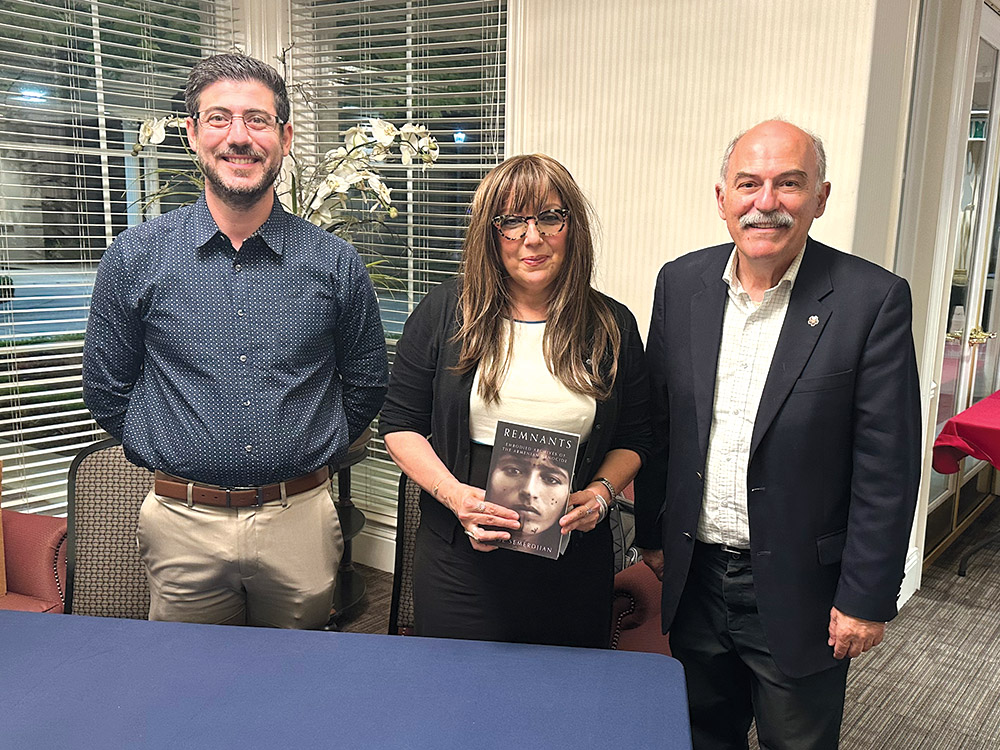
Left to right: Dr. Hagop Ohanessian, Dr. Elyse Semerdjian, and Prof. Barlow Der Mugrdechian after the April 25 talk.
Ani Sargsyan
Staff Writer
On Thursday, April 25, 2024, the Armenian Studies Program welcomed Dr. Elyse Semerdjian, Robert Aram and Marianne Kaloosdian and Stephen and Marian Mugar Chair of Armenian Genocide Studies at Clark University, to talk about her new book, Remnants: Embodied Archives of the Armenian Genocide. The presentation was made possible through the Ralph Shabazian Armenian Memorial Fund.
Dr. Semerdjian is a social historian on the Ottoman Empire, and her research focuses on the experiences of women and the Empire’s Armenian subjects. She has authored several books including Off the Straight Path: Illicit Sex, Law and Community in Ottoman Aleppo and her most recent book, Remnants (Stanford University, 2023).
Remnants emphasizes the treatment of women and children during the Armenian Genocide. Dr. Semerdjian explores how gender and the body figured centrally in not only the minds of the perpetrators, but the minds of the humanitarians who set out to rescue and reintegrate Armenian victims. The throughline of her book examines post-memory of the Armenian Genocide and how the uprooting of the Ottoman Empire’s Armenian population is remembered as a body horror, with the memory of dismemberment, tattooed skin, and the bones of martyrs.
The book is split into three parts: Bodies, Skin, and Bones. In part one, Bodies, Dr. Semerdjian presented a letter written by a Turkish gendarme who mentions an Armenian woman being held by force in a home. Dr. Semerdjian used this as evidence of “mutilated archives,” as the woman is not mentioned by name, and there was no resolution. She followed this with another letter, this time of an Armenian woman writing to her father. The woman recognizes the child she shared with her Armenian husband by name, but refuses to say anything about the one she shares with an Arab. The resentment she holds against those who held her captive, mirrors the first letter.
In the second section, Skin, Dr. Semerdjian talked about the lingering traumatic memory and stigma of tattooed Armenian women.
In this section, she explored ideas such as: how the tattooed skin of rescued Armenian women communicated both belongingness and otherness within the community, how marked skin produced feelings of rejection and shame, and how the tattoos that some women bore as a result of trafficking came to signify the shame of Islamicization and cultural genocide in Armenian post-memory.
The tattoos, for some women, were signs of protection given by Arab or Kurdish tribesmen. For others, they were reminders of traumatic experiences, and they got rid of them as soon as possible in order to not become ostracized by the Armenian community.
In the final section of her book, Bones, Dr. Semedjian discussed the memory of those who passed. She mentioned the eeriness of having a mass of land with martyrs and unmarked graves. She emphasized the importance of having a memorial, and presented a photograph of a man named Harutyun Hovakimian, who was tasked with rescuing the dead, and is pictured holding the skull of a small child. Those with an unmarked graves symbolize something intangible, and it draws you in. “A lot of our post-memories are informed by what we have heard from our grandparents, our family members and friends,” said Dr. Semerdjian, “this kind of cross-generational transmission is what I am interested in.”
Dr. Semerdjian closed the lecture with poet Peter Balakian’s words regarding the importance of having a monument in memory of those who perished. “It would be important for the Armenian monuments to be remade, said Dr. Balakian. “This is an historical ground with large ethical significance for the world…as the largest grave yard of the Armenian Genocide, Der el-Zor is a tragic and morally important place and space.”
 Hye Sharzhoom Armenian Action
Hye Sharzhoom Armenian Action